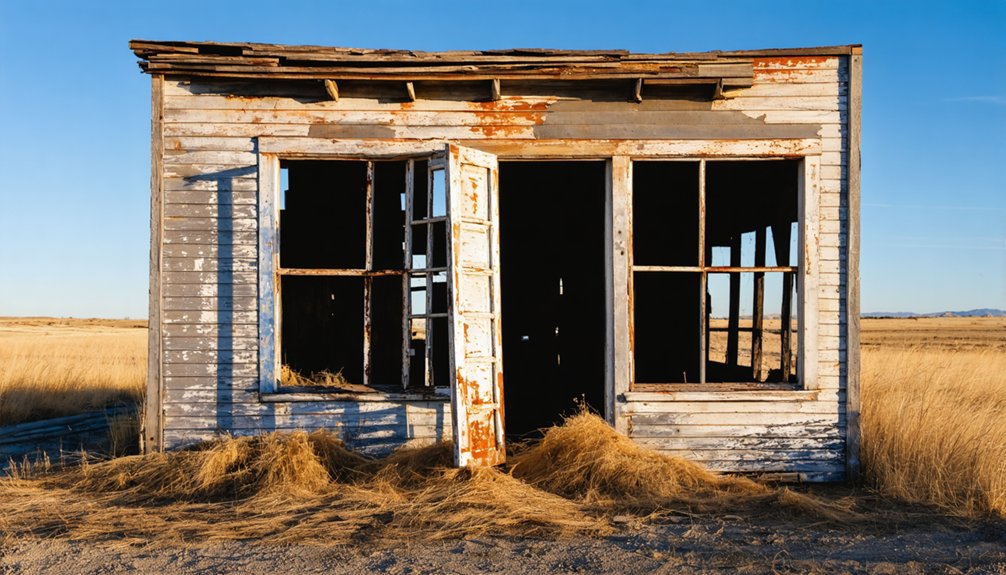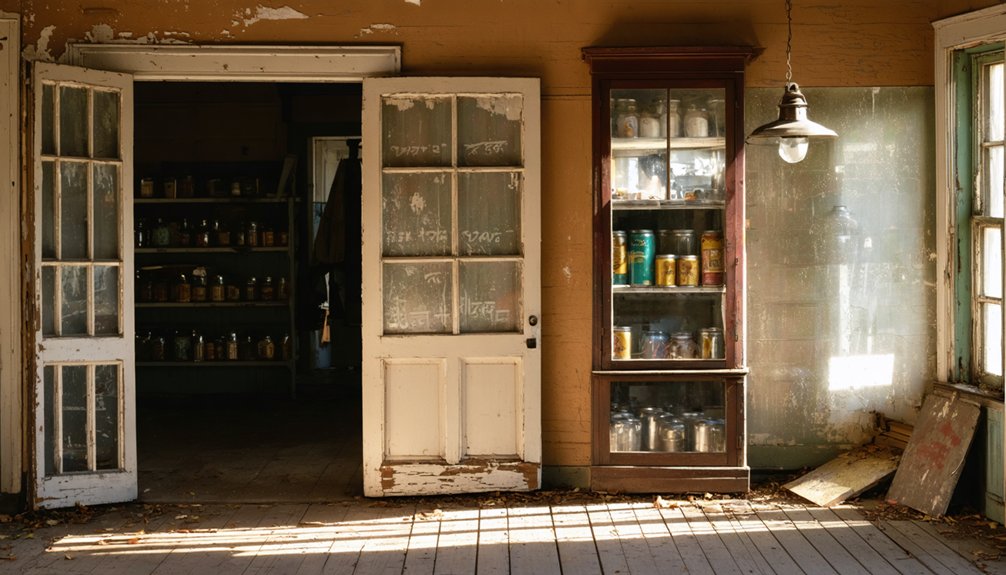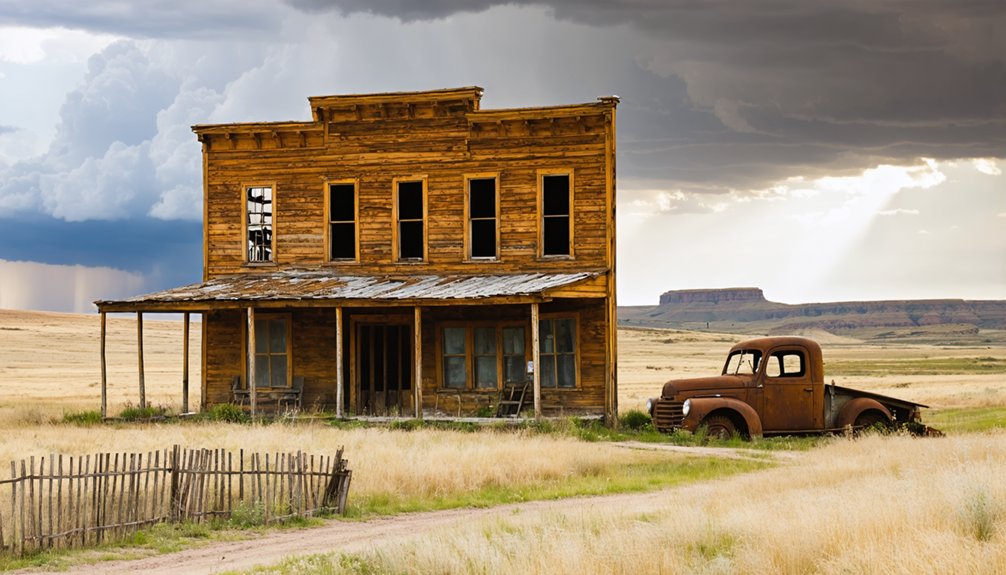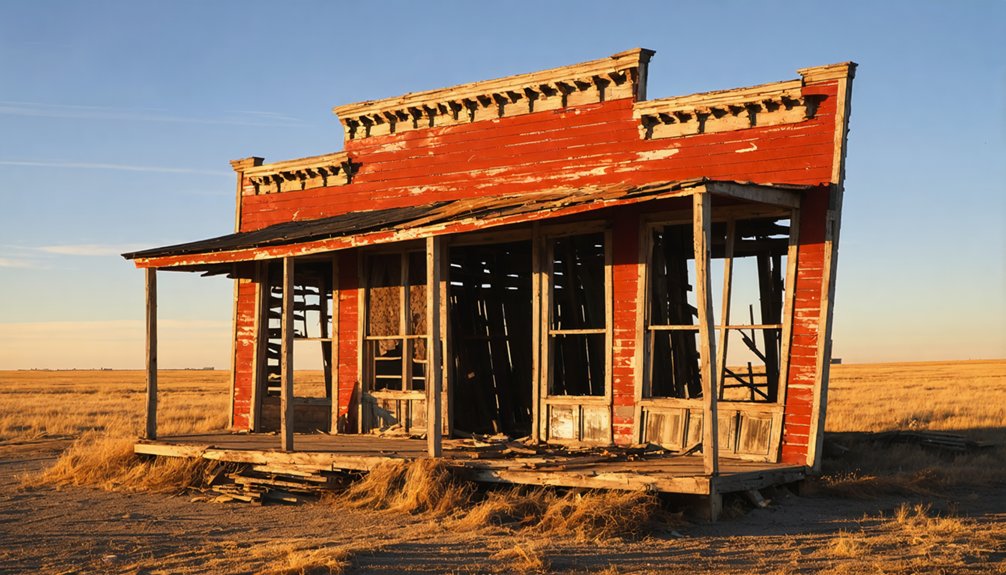You’ll find Ochre City’s weathered remnants in southeastern South Dakota, where it flourished as a railroad boomtown in 1886. After Dakota City’s railroad bypass, settlers relocated buildings to establish this new town, named after Edwin Parks. The community thrived through agriculture and rail commerce until the Great Depression, dust storms, and the railroad’s eventual departure led to its decline. Today, its deteriorating structures and repurposed hiking trails tell a compelling story of America’s prairie settlement era.
Key Takeaways
- Founded in 1886 near railroad tracks, Ochre City grew rapidly from relocated buildings and businesses from nearby Dakota City and Milltown.
- Economic prosperity peaked with railroad access, transforming local agriculture and growing the population to over 260,000 by 1885.
- The Great Depression devastated the community with severe drought, dust storms, and farm foreclosures, leading to significant population decline.
- Railroad departure in mid-20th century caused business closures and job losses, accelerating the town’s transformation into a ghost town.
- Currently features deteriorating historic structures, with preservation efforts focusing on hiking trails, guided tours, and building restoration projects.
The Rise of a Railroad Boomtown
While many frontier settlements struggled to attract railroads in the 1880s, the birth of Ochre City began when the railroad route bypassed established towns like Dakota City and Milltown in 1886.
Railroad innovation transformed the landscape as settlers literally picked up and moved their buildings to be closer to the tracks, abandoning their former locations for better economic prospects. The Dakota City Advance, the area’s main newspaper, relocated alongside the businesses.
Pioneers uprooted entire buildings, dragging them toward the promise of prosperity that the railroad’s steel rails represented.
You’ll find the story of town identity particularly fascinating in how the community rejected the original name “Kirk,” which had been chosen for a Chicago businessman.
Instead, they petitioned for the name “Parkston,” honoring railroad employee Edwin Parks.
The boomtown’s rapid growth saw new construction at an impressive pace of one building per day, as the railway brought crucial connections to larger markets, mail service, and economic opportunities. Following the success of the Transcontinental Railroad in 1869, towns like Ochre City became vital links in America’s expanding rail network.
Daily Life in Early Settlement Years
Three distinct cultural practices shaped daily life in early Ochre City: communal living, gender-specific roles, and seasonal routines.
You’d have found yourself part of a close-knit community living in rectangular, one-room houses arranged in irregular rows, sharing resources and working together for collective defense.
Daily routines followed strict gender divisions – men hunted bison and deer on the prairie while women tended corn, beans, and squash in nearby fields.
As seasons changed, you’d join your neighbors in ceremonial gatherings, feasts, and dances that strengthened social structures.
Storage pits and communal granaries kept your winter food secure, while trade networks brought shell beads and pottery from distant villages.
Life wasn’t always peaceful though – conflicts with neighboring tribes sometimes forced communities to fortify their settlements.
The area’s earliest inhabitants, known as the Woodland People, left behind numerous artifacts including pottery shards and stone tools that provide glimpses into their daily activities.
The Mandan and Arikara established extensive trading relationships that brought prosperity and cultural exchange to the region.
Economic Growth and Agriculture
You’ll find that the railroad’s arrival in Ochre City revolutionized local farming by providing essential access to distant markets and reducing transportation costs for agricultural goods.
During the Depression years of the 1930s, you’d have witnessed the town’s farming community struggle with plummeting crop prices and severe drought conditions that forced many family farms into foreclosure.
The dramatic shift in agriculture’s fortunes has continued into modern times, where you’ll notice the local farm population has dwindled to a fraction of its peak years, with only a handful of large-scale operations remaining in the area.
Railroad’s Impact on Farming
Before railroads transformed South Dakota’s agricultural landscape, farming was limited by the challenges of transporting goods to distant markets.
You’ll find that railroad expansion revolutionized farming in the region, creating opportunities that weren’t possible before. As rail lines spread across the territory from 1870 to 1885, the population exploded from 12,000 to over 260,000 settlers. The development of T-shaped town layouts allowed for efficient loading and unloading of agricultural goods along commercial avenues perpendicular to the tracks.
Here’s how railroads sparked agricultural innovation and growth:
- They provided year-round transport of bulk crops and livestock at reasonable rates.
- They delivered essential supplies like fencing, fuel, and building materials to remote farms.
- They connected farmers to broader markets, making large-scale farming profitable.
You can trace the development of farming communities directly along these rail arteries, where towns sprang up as hubs of agricultural commerce and trade.
Depression-Era Agricultural Decline
While South Dakota’s agricultural prosperity seemed boundless during the railroad boom years, the 1930s ushered in a devastating period of economic collapse and environmental catastrophe.
You’d have witnessed your neighbors’ farms crumbling as severe drought and relentless dust storms stripped away up to 75% of the precious topsoil. The massive storms, known as black blizzards, ravaged approximately 100 million acres across the Great Plains. Farm foreclosures skyrocketed, with land values plummeting by 28% in the hardest-hit counties. Nearly one in ten farms changed hands through distress sales by 1934. Federal drought relief reached an estimated $1 billion by the end of the devastating period.
Despite federal intervention through programs like the Agricultural Adjustment Act, most farmers couldn’t recover their losses. They desperately expanded into poorer lands to offset declining returns, only worsening the topsoil erosion.
Modern Farm Population Trends
Despite South Dakota’s historical farm population decline, the state’s agricultural sector has transformed into a powerhouse of modern production, particularly in the dairy industry where cow numbers have more than doubled to 215,000 head since 2015.
You’ll find today’s agricultural landscape dramatically different from Ochre City’s era, with a stark east-west divide in farming practices. The eastern region’s rich soils support extensive row-crop production while western areas focus on rangeland cattle operations.
While population growth has slowed to 0.69% statewide, the impact on farm labor and rural migration presents unique challenges for agricultural communities. The Governor’s Office of Economic Development has successfully facilitated numerous dairy industry expansions through strategic investment initiatives.
- Large-scale operations now dominate, with eastern dairy farms averaging over 1,000 cattle.
- The dairy industry alone supports 14,000 jobs and generates $7.2 billion in output.
- Urban areas like Minnehaha County continue growing while rural communities face demographic pressures impacting farm labor availability.
Natural Challenges and Population Shifts

As natural calamities battered Ochre City throughout its brief existence, the town’s residents faced an unrelenting series of environmental challenges.
You’ll find the climate impact was particularly harsh, with devastating floods repeatedly destroying essential infrastructure and brutal South Dakota winters testing even the hardiest settlers.
The town’s remote location left you especially vulnerable when health crises struck, as demonstrated by the tragic 1919 influenza outbreak that claimed multiple lives, including a mother and her two children.
Isolation proved deadly during the 1919 flu epidemic, with the closest doctor days away as tragedy struck Ochre City’s families.
Without proper medical facilities or sanitation systems, you’d have struggled against disease outbreaks that accelerated the town’s decline.
Similar to how the Milwaukee Road bankruptcy devastated Okaten, the harsh environment, combined with poor soil quality and ongoing erosion, made farming difficult and sustainable living nearly impossible, pushing many families to seek better opportunities elsewhere.
The Railroad’s Final Departure
Once the railroad had been Ochre City’s lifeline, but its gradual retreat in the mid-20th century spelled doom for the struggling settlement.
You can still feel the railroad nostalgia when you walk along the abandoned rail beds where trains once thundered through, carrying passengers, mail, and precious cargo.
The economic ramifications of the railroad’s departure hit Ochre City hard in three devastating ways:
- Local businesses shuttered as freight shipping became impossible
- Essential services like mail delivery and passenger transport vanished
- Jobs disappeared as railroad-dependent industries collapsed
What you’ll find today are silent rail corridors transformed into trails, crumbling loading docks, and empty warehouses – stark reminders of how quickly a town’s fortunes can change when its transportation artery is severed.
Tourism Efforts and Heritage Preservation

While Ochre City’s industrial heart stopped beating decades ago, a dedicated group of preservationists and tourism advocates now breathes new life into this historic ghost town.
You’ll find thoughtfully developed tourism initiatives that transform old railroad grades into hiking trails and showcase the area’s rich mining heritage through guided tours. Local efforts have established visitor centers, safety measures, and essential amenities to make your exploration both comfortable and secure.
Experience thoughtfully preserved history, where abandoned rail lines become adventure trails and expert guides reveal treasures of our mining past.
Cultural preservation stands at the forefront, with community members collecting artifacts, restoring historic buildings, and sharing oral histories through storytelling workshops.
You’re not just visiting a relic of the past – you’re supporting a living museum where tourism revenue directly funds preservation efforts, creates local jobs, and maintains the authenticity of this remarkable piece of Black Hills history.
Current State of Buildings and Infrastructure
Today’s Ochre City presents a stark contrast to its preserved heritage sites and tourism initiatives.
You’ll find that time and nature have taken their toll on this forgotten South Dakota ghost town, where building decay has progressed considerably over the years. The current state of infrastructure remnants remains largely undocumented, making it challenging to assess what’s left of the original settlement.
When exploring Ochre City’s remains, you’ll encounter:
- Natural reclamation of the site by local grasslands and prairie vegetation
- Weather-worn remnants that continue to deteriorate due to South Dakota’s harsh climate
- Potential wildlife inhabitants that have made the abandoned structures their home
The lack of preservation efforts and detailed documentation means you’re witnessing a site that’s slowly disappearing into the landscape, much like other ghost towns across the state.
Legacy of Prairie Ghost Towns

You’ll see the transformation of rural communities like Ochre City mirrored across countless prairie ghost towns, where once-vibrant agricultural centers have faded into quiet remnants of the past.
These abandoned settlements represent more than just empty buildings – they’re living museums that chronicle the dramatic shift away from family farming and small-town life that defined the American prairie for generations.
Walking through Ochre City’s weathered streets, you’re witnessing the tangible evidence of how modernization and changing economic realities have reshaped the heartland’s agricultural heritage.
Rural Community Transformation
Throughout America’s heartland, the haunting transformation of rural communities into ghost towns tells a poignant story of economic upheaval and social change.
You’ll find that community resilience has been tested by dramatic demographic shifts, as populations dwindled from hundreds to mere dozens. The switch from bustling railroad hubs to abandoned tracks marks a profound change in these once-vibrant places.
When you explore these transformed communities, you’ll discover:
- Former commercial centers have become private properties, often fenced off and inaccessible.
- Aging populations remain while younger generations seek opportunities in urban areas.
- Large agricultural operations have replaced smaller family farms, fundamentally altering local economies.
Despite physical decline, some communities maintain their identity through reunions and preservation efforts, though they’ll never recapture their former liveliness.
Vanishing Agricultural Heritage
The rich agricultural legacy of America’s prairie ghost towns reveals a bittersweet chapter in our nation’s farming history. You’ll find the remnants of vanishing traditions in abandoned grain elevators, empty stockyards, and weathered general stores that once bustled with life.
These structures tell the story of your ancestors who built thriving communities around railroad lines and fertile prairie soil. Cultural nostalgia draws you to these forgotten places, where wooden churches and crumbling brick storefronts stand as silent witnesses to an era when small family farms and local commerce sustained vibrant communities.
The mechanization of agriculture, railroad abandonments, and harsh environmental challenges forced many to leave their prairie dreams behind. Today, these ghost towns preserve essential lessons about rural American life and the dramatic transformation of our agricultural heritage.
Frequently Asked Questions
Are There Any Reported Ghost Sightings or Paranormal Activity in Ochre City?
You won’t find any documented ghost encounters or paranormal investigations in this location. While abandoned towns often spark supernatural intrigue, there aren’t any verified reports of ghostly activity here.
What Happened to the Original Town Records and Historical Documents?
Like scattered leaves in autumn wind, you won’t find the town archives today. Poor document preservation, fires, and hasty abandonment meant most records were lost or destroyed when mining operations ceased.
Where Did Most Residents Relocate to After Leaving Ochre City?
You’ll find that relocation patterns led most residents to Deadwood and Rapid City, where they sought better economic opportunities. Some moved to Hill City and Lead, while others left the Black Hills entirely.
Can Visitors Legally Collect Artifacts or Take Souvenirs From the Site?
While you might be tempted to collect memories in physical form, you can’t legally remove artifacts – legal regulations strictly protect the site’s historical integrity. Take photos instead of souvenirs.
Are There Any Surviving Descendants of Original Ochre City Settlers?
You can’t verify any surviving descendants with certainty since there aren’t published descendant interviews or documented family histories linking current individuals to original settlers of this remote mining town.
References
- https://www.legendsofamerica.com/sd-okaton/
- https://www.youtube.com/watch?v=_0WNYsFLSLA
- https://core.ac.uk/download/pdf/345016075.pdf
- https://www.sdpb.org/rural-life-and-history/owanka-south-dakota
- https://icatchshadows.com/okaton-and-cottonwood-a-photographic-visit-to-two-south-dakota-ghost-towns/
- https://www.blackhillsbadlands.com/blog/post/old-west-legends-mines-ghost-towns-route-reimagined/
- https://en.wikipedia.org/wiki/List_of_ghost_towns_in_South_Dakota
- https://www.geotab.com/ghost-towns/
- https://www.ammhistory.com/The-Railroad-Part-1
- https://blackhillsvisitor.com/learn/timeline-of-black-hills-railroads/



